My first week back on the island I had the privilege to meet Albert Shepard, Curator at the Whale Museum. Albert is currently working on cleaning the bones of the recently deceased young female Southern Resident killer whale L112 (Sooke/Victoria) whose body washed up on the shores of Long Beach, WA this past February. I first learned of Sooke’s death just a few short days after the news broke. Ironically, I was in the midst of packing for the Beam Reach course. In the following weeks I read articles, watched necropsies, and thought about what could have possibly happened to this young, seemingly healthy whale. After arriving on San Juan Island in March for Beam Reach I learned a lot about the investigation into Sooke’s death. There are a number of theories out there as to the cause of death, but no one is really sure as to what happened to her.
The last few months of thinking about Sooke and learning about her death were pulled together into a momentous experience when I was able to see her beautiful skeleton laying out in the sunshine at Friday Harbor Labs. Spending two afternoons with Albert, just looking at the pieces of the skeleton come together was incredible. I have been in love with orca whales since I was five years old, and seeing the structure of an orca — what gives it shape and strength and the ability to swim — was mind-boggling. I wish that I could let all of you have the same experience of admiring L112’s skeleton in all of its beauty, and someday hopefully you will get the chance. The Whale Museum is working on a display in memory of L112 that will include her skeleton. Until then, I hope these pictures will give you an idea of how beautiful and intricate Sooke’s skeletal structure really is.
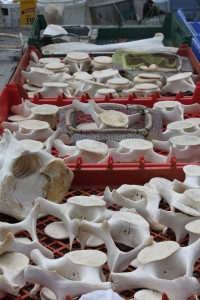
Vertebrae
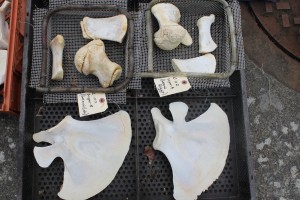
Scapula and other bones
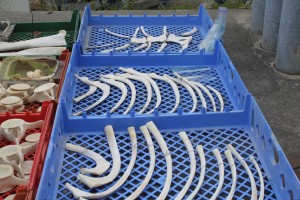
Ribs
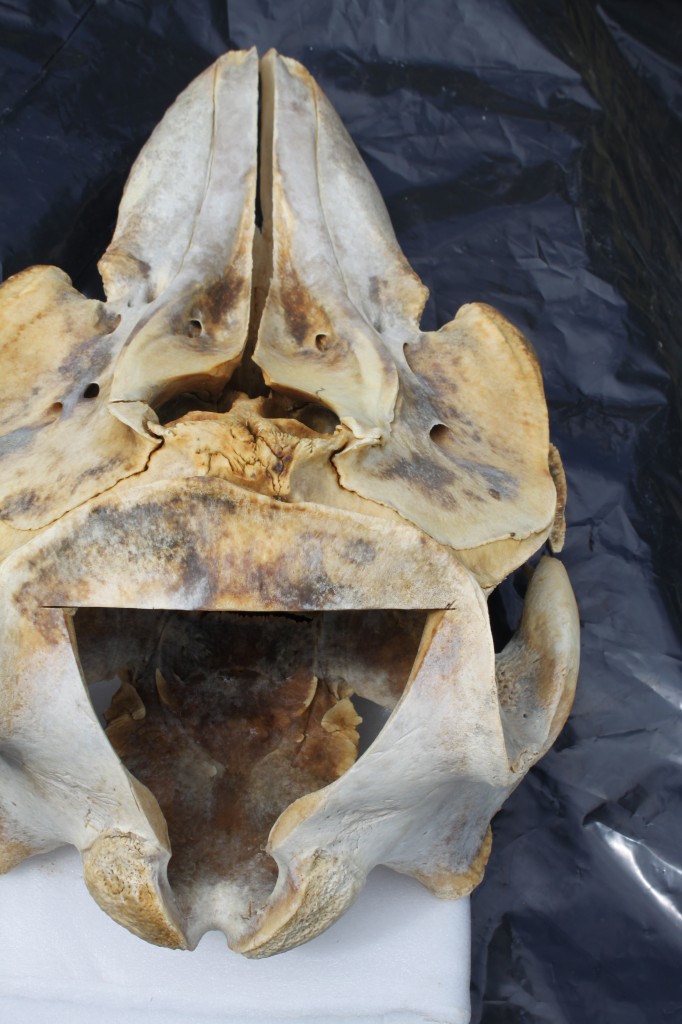
L-112 Sooke/Victoria skull
For more information on Sooke and the investigation into her death please go to the following resources:
Beam Reach blog
Center for Whale Research
http://www.whaleresearch.com/encounter_pages/2012/news_L112death.html
The Whale Museum
http://www.whalemuseum.org/programs/stranding%20network/Sooke.html
Read More
I never thought I would be able to call the sea my home, but after living on a boat for an extended period of time, I can truly call myself a sailor, and a sustainable one at that! The Gato Verde is the only biodiesel electric commercial sailboat in the country, which makes it pretty darned special. It’s considered sustainable because of the myriad of things that keep the cat green, like being able to use the slightest touch of wind to power the boat. When the wind is lacking, the boat simply runs on electric power, and when electric power runs low, the boat is backed by biodiesel.
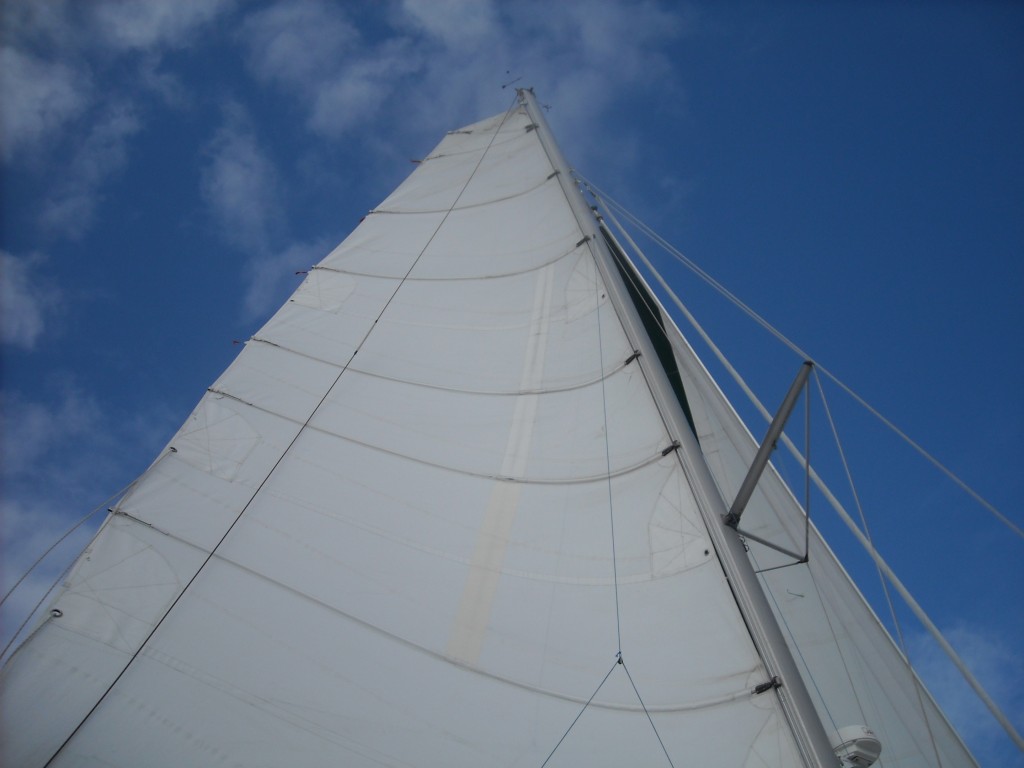
Sailing!
The electric power of the Gato is provided by heavy, lead acid batteries. These batteries are the same batteries that can be found in cars and their weight adds to the drag on the boat. In order to make the Gato more efficient and sustainable in the future, the type of battery used could be switched to lithium polymer batteries, which are lighter, more abuse tolerant, and could power the boat alone for a full four hours, as opposed to the current two hours that the lead acid batteries provide now. In addition to the battery type change, Captain Todd hopes to yet improve the sustainability of the Gato by converting the current black water system to a grey water system.
While we were out sailing through the Salish Sea, we had to constantly be conscious of our black water system. The black water system on the Gato Verde is the where the human waste is held, home to a unique ecosystem of hazardous pathogens, and it was how we kept our waste from entering the marine environment. We had two holding tanks on the boat, a primary and a secondary. When the primary holding tank was filled, it was pumped into the secondary holding tank and when both tanks were full, it was time to make a trip to pump out. We created a decent pump out rule, as pumping out is not always the most pleasant thing to do. The rule was that whoever did not pump out had to buy ice cream for whoever did pump out. Because of this, pumping out ended up being one of our favorite things to do on the boat! In addition to measuring the amount of waste produced, daily calculations were made of fresh water usage, biodiesel fuel, and power consumed.
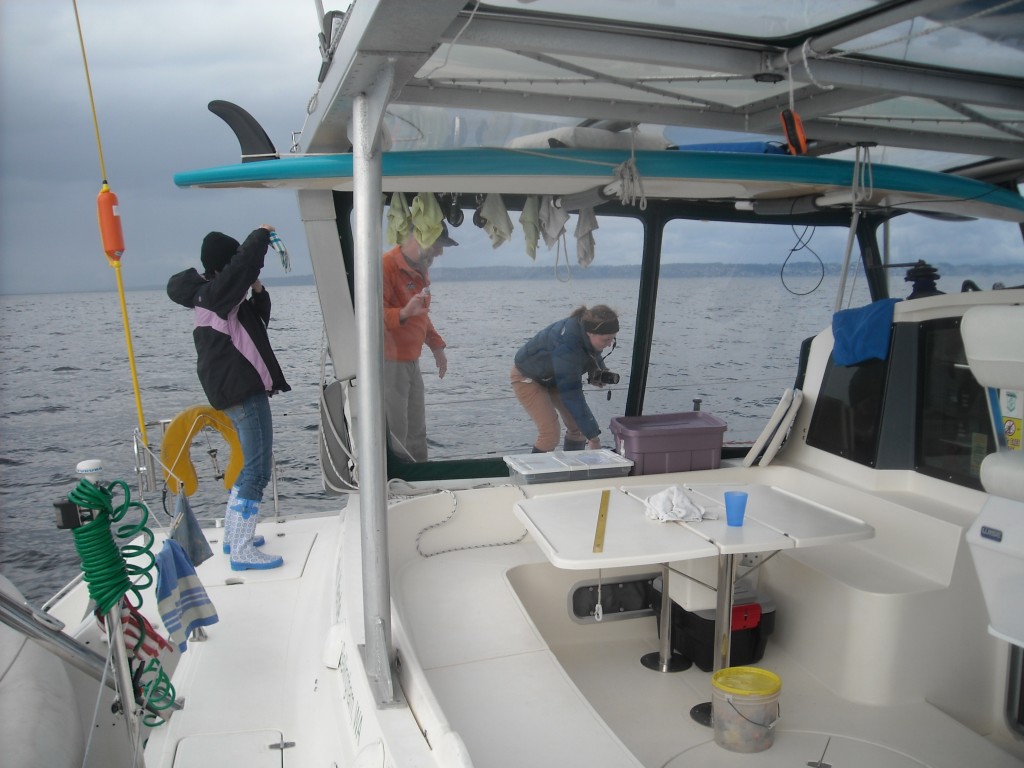
More Sailing!
When the environment permitted, we used it to maximize our efficiency. A few days out on the Gato allowed us to hoist the mainsail and test our skills at sailing. We used the wind to our advantage and optimized our angle with the wind, maneuvering the boat with the jib sheet by tacking. In addition to the different aspects of sailing, we learned a lot of other valuable information, like how to tie a double sheet bend knot, which is used to tie two lines together. My all time favorite knot was the bowline. I got so good at tying a bowline that at one point, I somehow managed to tie one single handed! Another knot I became very quick at tying, which I think is the most aesthetically pleasing knot of all, is the cleat hitch. The cleat hitch was used every time we docked instead of mooring or anchoring.
There were a number of tasks to accomplish when we anchored for the evening. To start, we lowered the anchor into the water. After the anchor was lowered, a bridle was put on the anchor chain to reduce the tension on it. We observed the angle of the anchor chain each time we anchored to be sure the anchor was secured at the sea floor.
One of my favorite things about sailing was the rare opportunity we had to view the southern resident killer whales from the water. As we approached the end of our voyage, we were all wondering when we would be able to see the greatly anticipated whales. Finally, three days before our trip ended they showed up and stayed in the Salish Sea long enough to be with them on each of our last days on the boat. Our last day, the whales were not very vocal, but they put on quite a show for us at East Point. We were running from port to starboard, shouting out behaviors like crazy! It was amazing to see how much of a mood booster the whales could be.
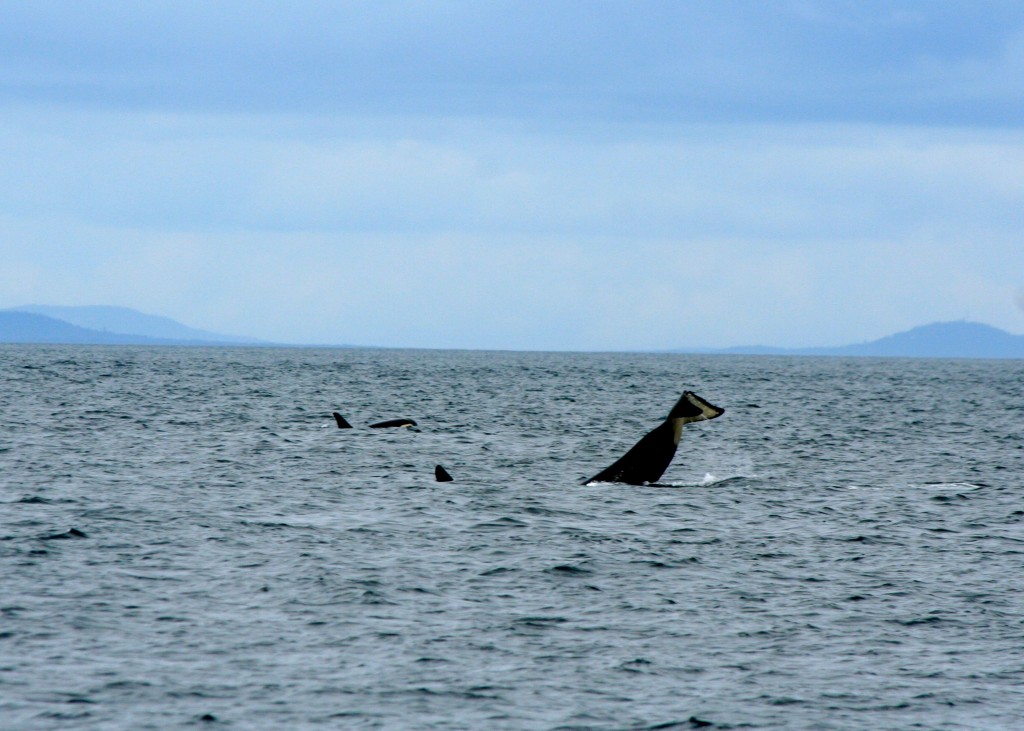
Killer whale tail slap, photo courtesy of myself (my pride and glory)
After a long, arduous, and exhausting week here at the Friday Harbor Labs, we have finally passed the threshold of our looming presentations. I will be sad to say goodbye, and while I know that I will never, ever forget the time I have spent here, it’s always difficult to leave a place where you feel so at home. This truly has been the experience of a lifetime. I have made lifelong friends and learned valuable skills and information that I will be able to use in almost every situation. Congratulations to the Beam Reach 121 class of spring 2012, you’ve done it!
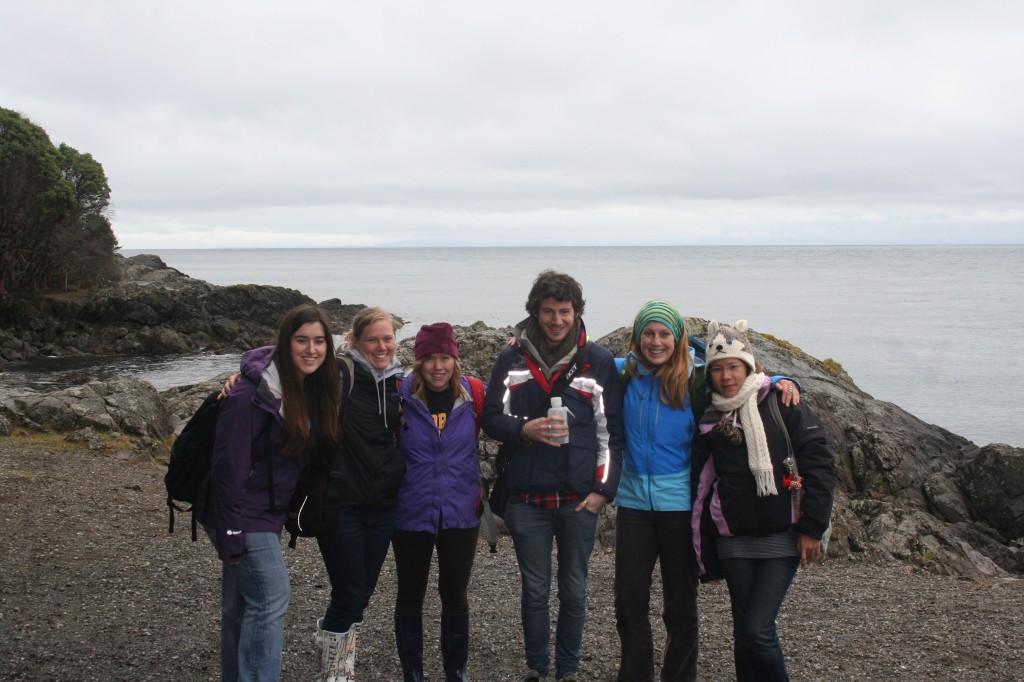
I love these guys!
We take so many things for granted on land. Water appears to pour from an endless well and electricity is immediate at the flick of a switch. On the ocean, however, these luxuries have to be rationed as we can only use what we can store. In addition, any waste products, such as black water, have to be stored, and disposed of responsibly. Whilst out at sea, for example, human waste was carried around with us until it could be ‘pumped out’ at Roche Harbor. The Gato Verde had two holding tanks for the purposes of storing human waste. The three weeks spent on the Gato Verde have certainly helped me to understand and appreciate how much more sustainable we can all live. In the past when I have heard the term sustainability, I have automatically associated this with either a big change in lifestyle or a large investment. The reality, however, is that we can all live healthier and more sustainable lives if we just use things in moderation.  Whilst out on Gato, as part of our morning chore rotations, measurements were taken of water usage, sewage level, and amount of biodiesel used. This allowed us to graph and monitor our footprint over the duration of the trip.
Compared to many vessels, the Gato Verde, a 42 ft electric biodiesel hybrid catamaran , is pretty special in that it was modified to be more environmentally friendly. Such modifications include converting to LED lights, and changing the sail plan to optimize efficiency. This involved adding a screecher to take full advantage of any wind, and by making the main sail a ‘square top’ to increase surface area. There is no cleaner fuel than the wind itself. If there is little wind then the Gato uses quiet electric motors to help it move through the water. Compared to most motors, these have little noise impact on the environment. The Gato also burns biodiesel, a renewable fuel source, that not only powers the vessel through the water, but, also can be utilized to charge the boats batteries.  Despite the Gato’s current success in being sustainable, further modifications are being considered for the foreseeable future. In the short term, Captain Todd hopes to add solar panels and a wind generator to be even more energy independent. Research is also being directed into alternative grey water systems.
Although we were busy collecting physical oceanography measurements such as conductivity, salinity, visibility, and plankton density, there were a number of opportunities for us to learn about the Gato and the process of sailing. In the early stages, there was so much terminology to get our heads around and knots such as bowlines and sheet bends seemed impossible. In the latter part of our trip, however, this new language felt a lot more natural. For example, when asked to pull in the jib, I knew that this was the middle sail (not to be confused with the main sail or screecher). The masts supporting these sails were themselves held in place by a forestay and shrouds. Out of all the sails, we used the jib the most as it is designed to operate in lighter winds. By using the wind to our advantage, less fuel was needed to travel the same distance. In addition to using the wind, tides and currents were also exploited. By using the environment we could ultimately be more sustainable. After long days of science, we would head back to either moor or dock on nearby islands. Out of all the places we visited, my favourite was Patos Island. On occasions, we were forced to anchor. This however was avoided wherever possible because of the damage it inflicts on the marine environment. Towards the end of the two weeks, we could prepare the anchor with as little as two students. We were mostly responsible for directing Captain Todd, operating the windlass, and preparing the bridle. The idea behind the bridle is that once attached,  it helps to distribute the stress on the boat. The final stage of the  anchoring process involved attaching the chain hook.
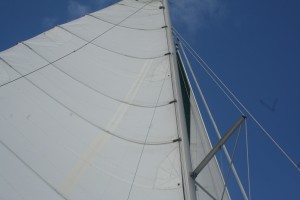
Raise the main sail
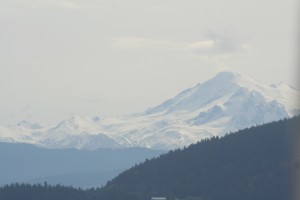
View from my berth
It was a sad moment when the Gato sailed off from the Friday Harbor labs. Although I was happy to be back on land, I am now itching to get back on the water. I feel that living onboard the Gato has prepared me well for the future. In the space of two short weeks we have learnt so much, skills that will last a lifetime.
Read More
We’ve been back on land for two days now and we’re all still adjusting to life on solid ground. I used to think that from my experiences as a kid on a sailboat, that I knew what it was like to live on a boat… that couldn’t have been farther from the truth. After two weeks on the boat we only just began to scratch the surface of what living in the field is like. It was like no experience I’ve ever had, and I will never be the same because of it. In attempt to stop you from thinking that this experience was anything less than incredible I will give you a little behind the scenes glance of what it was like, and how much fun we actually  had. Our days normally started around 8:00 am in the galley for breakfast. After that we took care of our chores for the day which ranged from cleaning the decks and heads to acting as the navigator and mapping a course for the day. We were able to stay at some pretty amazing islands, like Jones pictured below.
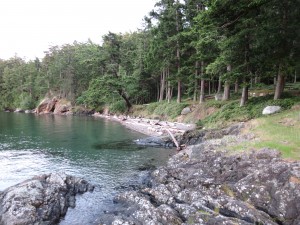
Since our days with whales were limited we collected a lot of physical oceanographic data from the CTD and other equipment like the Secchi disk which measures visibility in the water. We even had the opportunity to sample at one site for the entire day to see how the ocean changed at that one location over time.As the days without whales continued we became more creative with our data collection. It was in these days that we learned how far we were willing to go for our research. Phinn, one of the other students, decided to jump in the water every hour for 7 hours during the day to get horizontal secchi measurements as opposed to the usual vertical readings. After jumping into 8 degC water ourselves earlier that week this seemed absolutely crazy. Even so we jumped in again on a later day and swam around for 25 minutes. With the Olympic mountains in the background it was absolutely breathtaking… oh wait that was the water.
After a week on the boat with no reports of whales we were getting antsy. We delved into collecting as much data as we could and in turn analyzing that data, which I am still doing. We were very successful in collecting a lot of data. Finally we ran into some luck and heard of the whales coming in through the Strait of Juan de Fuca. Even though we woke up at 5:00 am to listen to hydrophones we missed them passing our anchorage and we had to play a bit of catch up. We eventually caught up to the whales and were able to collect both behavioral and acoustic data using the 4 hydrophone array. Suddenly our other needs became secondary and we adjusted course to follow the whales. We ended up having two more days with the whales as they led us from one end of the Salish Sea to the other. Our last day with them was amazing. We were with the whales for about 2 hours and witnessed some amazing behavior like spyhops, tail slaps, and even a few breaches. All of this set against the background of the sun setting on the horizon. While we had some struggles with adjusting to this life style it was an absolutely amazing experience that was hard to walk away from.

What made this experience so special was the boat we were on, The Gato Verde. This is no ordinary boat, it is the first plug in diesel electric hybrid charter boat on the west coast. Stretching to a luxurious 42 ft the Gato was an incredible home away from home. It isn’t special simply because of the amount of space aboard, but because the boat is a pioneer in the field of sustainable boating. Most boats have a motor that runs on gasoline that in turn powers the propellers which move the boat through the water, but the Gato isn’t like any other boat. Captain Todd Shuster added a diesel generator, and a large battery bank in order to make the boat more green. The generator runs on diesel which is cleaner and less explosive than gasoline and the battery banks helps create more clean energy. This would be all fine and dandy by itself, but the Captain took the extra step and taught us about why he made the changes to the boat and how it is creating more sustainable travel and less impact on the environment.
As part of our course we learned about sailing and the different parts of the boat. We even had a knot tying lecture, I can now tie several knots including a reef knot, clove hitch, and cleat hitch. The cruise began with us as students learning about the different aspects of sailing and quickly turned us into actual sailors. We regularly helped raise the jib for sailing and deployed the anchor at nights when we were not on a dock or mooring buoy. We did not get much ideal weather for sailing but when we did we made sure to take advantage of the wind and put our mainsail up. Sailing is another example of how the boat is green. When we had ideal weather conditions we could take advantage of our environment, turn the motor off and use the power of the wind to move the boat. While docked one night we rested next to another sail boat that had a wind generator. This acts like a small turbine that harnesses wind energy and can be used to power the boat. Adding this to the Gato would be yet another way to make the boat more sustainable. One aspect of sustainability still being addressed is the issue of blackwater. Blackwater is waste water loaded with  biological material like feces. Living on a boat we naturally accumulated black water that was stored in holding tanks since we could not just dump the waste into the ocean. It poses a danger to the environment due to the amount of bacteria and contaminants from human waste that are not naturally occurring in the ocean. So we had to pump out our waste at pumping stations like the one in Roche Harbor.
While some aspects of living on a boat were challenging, like timing our location with our need to pump out our holding tanks, and living in such close proximity to people, this was the most amazing experience of my life. I learned so much about the Salish Sea and clean boating as well as about myself and just how far my limits reach. I am sad that our time on the Gato has come to an end, but now I get to analyze the results from all of the data we took and put my piece into the larger puzzle that is the Salish Sea.
Read More
Wow! This is all I feel I can say to properly describe our first cruise on the Gato Verde this past week. It was absolutely incredible. We left the labs Monday morning practically chomping at the bit to get to see the Gato for the first time after hearing and reading so much about it. When we finally got there, to my surprise, the boat seemed much bigger than I thought it would be, which trust me when living with the rest of my class is a good thing. All of our weirdness would not fit into a small boat.

The Gato Verde
After getting oriented to the boat we left and motored to Sucia island where we docked for the night. But as they say life’s not about the destination, its about the journey, which didn’t fail to stand true on the trip over. We all put our rain gear on and sat on the trampoline that stretched between the two hulls of the catamaran and were absolutely soaked by oncoming waves. It’s good to know that when REI tells you your pants are waterproof, they really mean it!

One of the challenging things about living on the boat is that we have to cook our own meals and plan our cooking ahead of time. I can definitely say that my cooking abilities have exponentially increased since they were pretty much limited to frozen foods and pasta, oh and I make a mean bowl of cereal. Although, you should know that I am a bit like a 5 year old in that I dislike almost all vegetables and cooking for vegetarians means I ate a lot of vegetables. I could practically hear the 5 year old inside me throwing a temper tantrum, but I was amazed upon finding that vegetables aren’t inherently evil, they’re actually rather yummy.
Now that my brain was properly fueled we learned about all of the science equipment we would be using and have available for our projects. Staying consistent with my shopping tendencies I was instantly fascinated by the CTD which measures conductivity, temperature, and depth, and happened to be worth roughly $50,000. Needless to say every time we deployed the CTD I had a miniature heart attack anticipating everything that could go wrong. After a day of collecting data on the CTD we realized that we weren’t actually recording any data. Robin finally realized that the ring around the start button was to protect the device during transit and was actually not a stylish accessory. We removed the ring and finally got successful data uploading from the CTD to the computer. After several deployments we got the hang of it and I am excited to start taking data for my project.
Today we worked on our service project that we are required to complete for the course. We decided to work with the San Juan County Land Bank and help with Garry Oak restoration on Cady Mountain. First we learned a little history about land use in the San Juans and the transformation the islands have seen since colonization. Then we took a trip to the Cady Mountain preserve to actually work hands on with Garry Oak restoration. We were able to help cut down trees to save trees… don’t think too hard about this it made my brain hurt. Actually, we were cutting down/ trimming other trees that were out-competing the oaks for sunlight. Don’t worry, we weren’t running through the forest willy nilly cutting down trees. We had a lot of fun helping to restore a beautiful area on the island while wielding really awesome ninja hand saws. I’m pretty sure it doesn’t get much better than that.
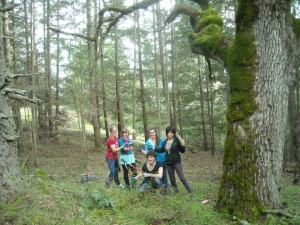
This week we are writing our proposals for our projects and will be finalizing them by Sunday before we head back out onto the Gato on Monday for our 1 week cruise of data collection. Hopefully the whales will be more cooperative and actually be in the San Juans while we are as well. Either way it is going to be an exciting adventure complete with sailing songs, random fits of laughter, and a lot of Sriracha.
Read More
Oh my Gato, what a week it has been! Monday began with an early wake up call and a hurried morning bustle in preparation for our first voyage on the Gato Verde! The six of us, Dana, Phinn, Taya, Breanna, Jamey and I stuffed ourselves into the Washington State Ford Explorer, only to drive five minutes to wait in line to board the ferry. While we waited, we decided to get coffee in a little cafe nearby. I really don’t like coffee, but I thought I would try a mocha milkshake considering that most milkshakes, regardless of the flavor, are delicious. It turned out to be a little too strong for my liking, but I drank most of it anyway. On the ferry, Phinn, Taya and I found a fruit themed jigsaw puzzle and started in on it right away. I’m not sure that I have ever felt so concentrated and determined in my life and I think it was the caffeine. We worked diligently on the jigsaw throughout our ride and we even had people betting on whether or not we would finish before we had to get off. We worked until the very last second we could, only to miss finishing it by about ten pieces. Do you have any idea how unsatisfying it is to miss finishing a puzzle by ten pieces? Needless to say, it was a very long ride to Bellingham as I stewed over the unfinished puzzle.
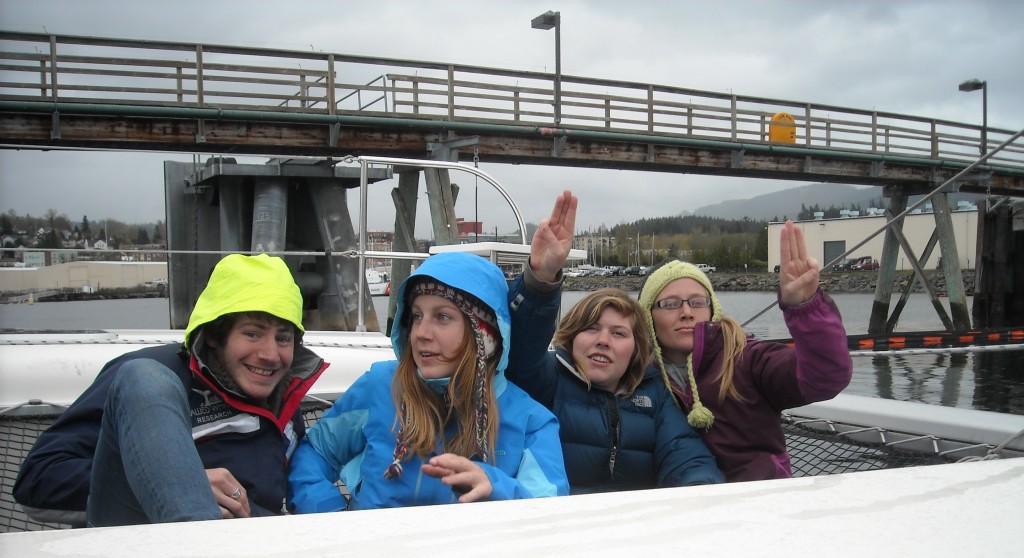
Phinn, Bre, Jamey and me hanging out on the trampoline before leaving Bellingham
When we arrived in Bellingham, we were welcomed aboard our new home on the water, the Gato Verde, by Captain Todd and had a brief orientation of the catamaran. The next couple of hours were spent loading the Gato with the plethora of science gear we brought with us and the many wonderful food ingredients we needed to make gourmet meals out at sea, including, but not limited to, milk chocolate, asparagus, white chocolate, eggplant, dark chocolate, loads of cheese, chocolate covered pretzles, tea, and chocolate brownie mix. By the end of our voyage, there was a pretty big dent in our food supply and not a hint of chocolate left. A short time later, last minute, final preparations were made and our four day journey began!
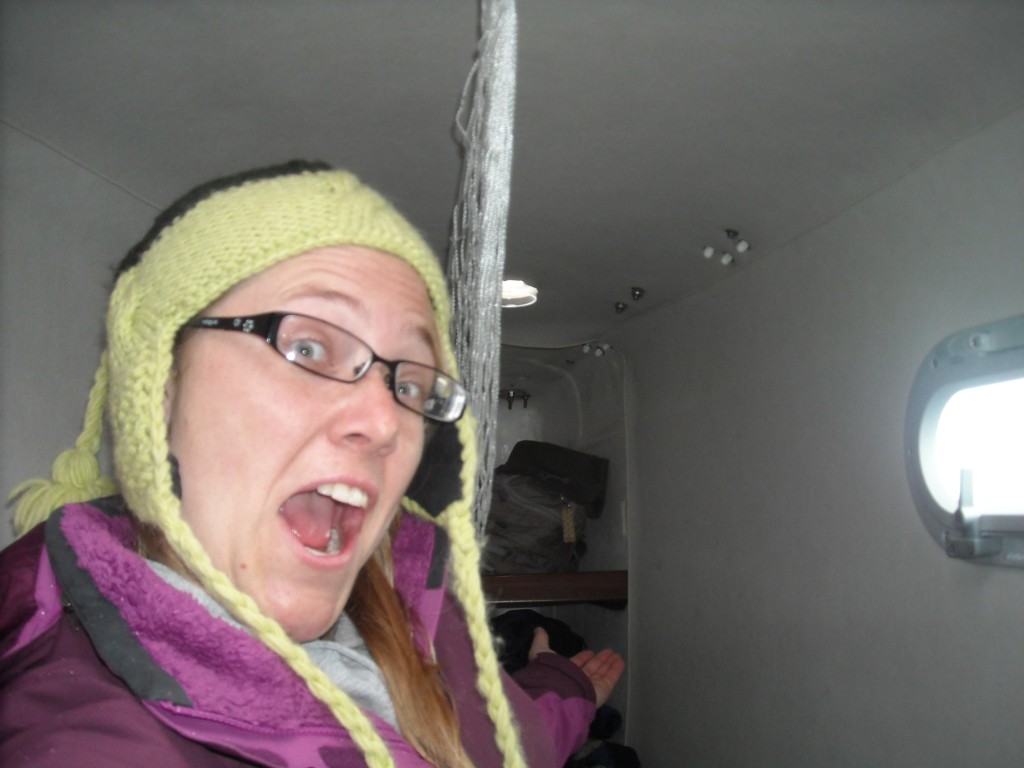
My berth
I had never spent an extended period of time on the water until this week and I loved every minute of it! The weather was decent and we spent the first afternoon on the front of the Gato, basking in the sun, being showered with waves on the trampolines. We docked for the night at Fossil Bay, on Sucia Island, and were welcomed by the most gorgeous sunset I have ever seen. I live in Tucson, Arizona, and nothing can compare to an Arizona sunset, but this was spectacular! Night fell fast and before I knew it, I was rocked to sleep by the gentle arms of the ocean, in my tiny little berth on the forward, starboard side of the Gato.
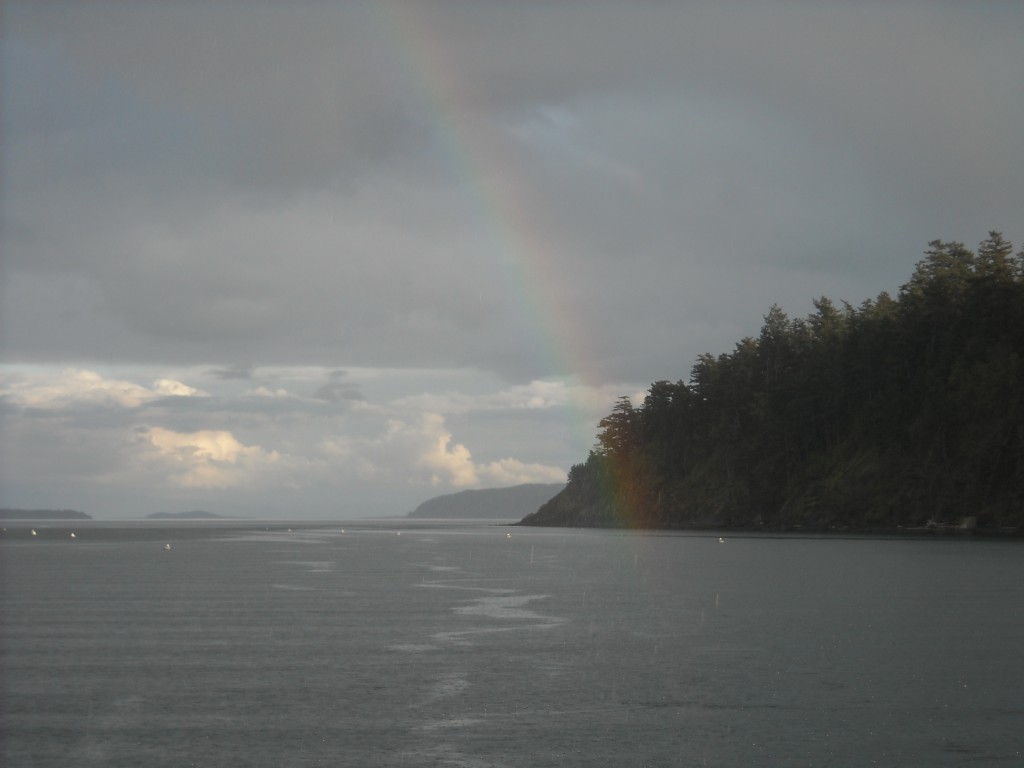
A view from the Gato at Fossil Bay, Sucia Island
The next few days out on the water, we learned how to deploy our scientific instruments, such as the CTD, to measure the conductivity, temperature, and depth of the water, a niskin bottle to collect water samples, a secchi disk to measure the water’s visibility and of course a hydrophone to get a feel for listening to the aquatic world beneath us. We traveled all over the Northern Inland waters and even floated into Canadian waters for about 20 seconds. It was my first time being in Canada and I was stoked! We also learned some of the fundamentals of sailing, like tacking, which was my favorite part of the trip! Sailing is so much fun! We had a good amount of down time during our adventure to relax on the Gato and explore the islands after we had docked for the night.
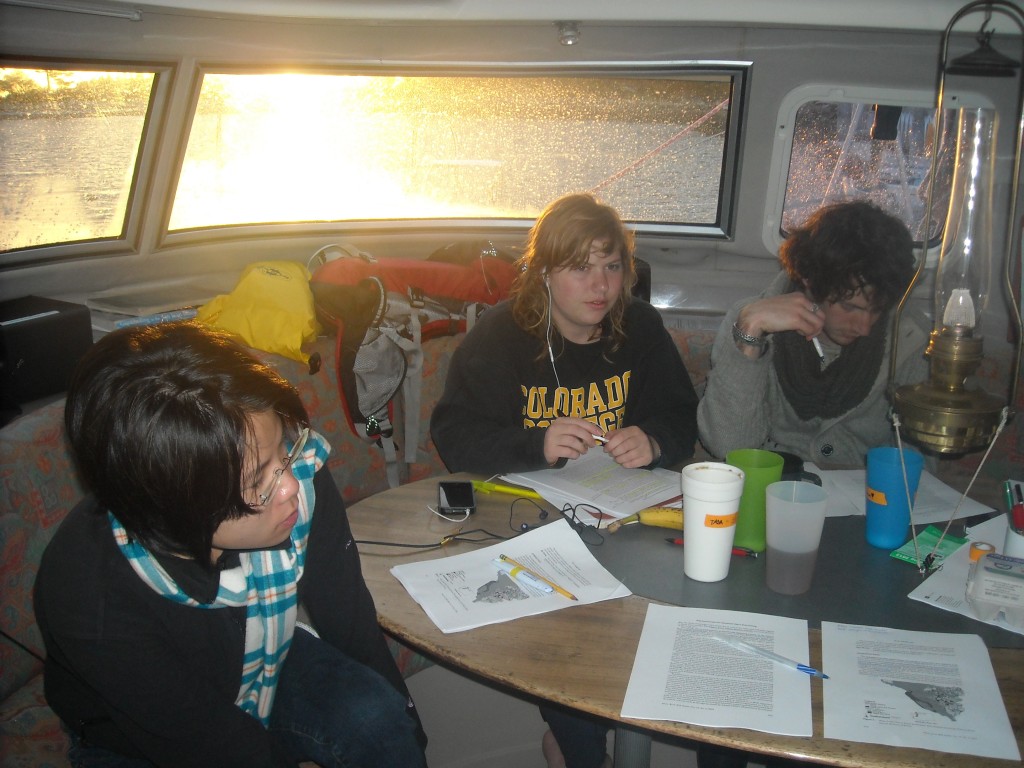
Taya, Jamey and Phinn working diligently
Our time sailing was full of great learning experiences. In the mornings after breakfast, our responsibilities included things like washing the decks and cleaning the heads (bathrooms) to rid the catamaran of mung, and fulfilling a systems report to monitor how much fuel, fresh water, and sewage storage we were using. We also had a navigator who listened for the weather report, observed tides and currents, and determined our course for the day. For this trip, I had a chance to clean the heads, do the systems report, and navigate. Each job was very different, but equally as important as the next.
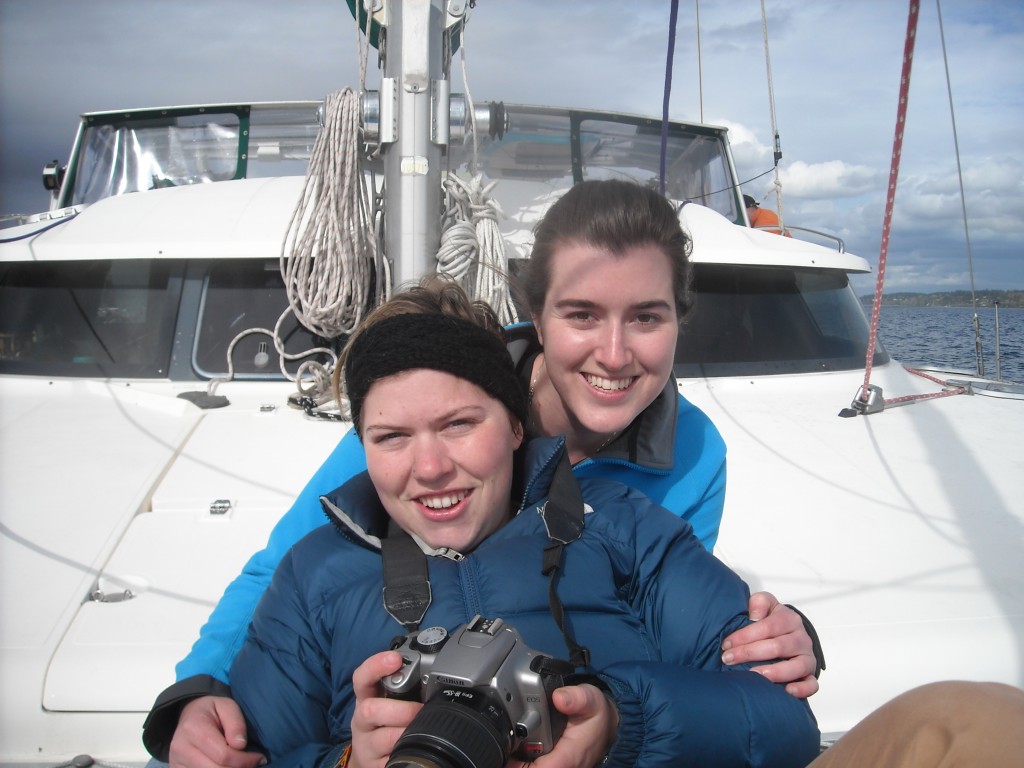
Jamey and Dana relaxing on the catwalk
Not only did I learn about science and my upcoming research on this voyage, but I also learned a great deal about the people with whom I am to share the Gato for our upcoming trips. I have gotten to know my new friends pretty well in the time that we have spent on land at the Friday Harbor labs, but being confined to a catamaran with them has allowed me to get to know them even better, especially when a common sailor theme song continuously resonates through our heads. As has been the theme of my time here on the island, things just keep getting better and I can’t wait for our next grand adventure!
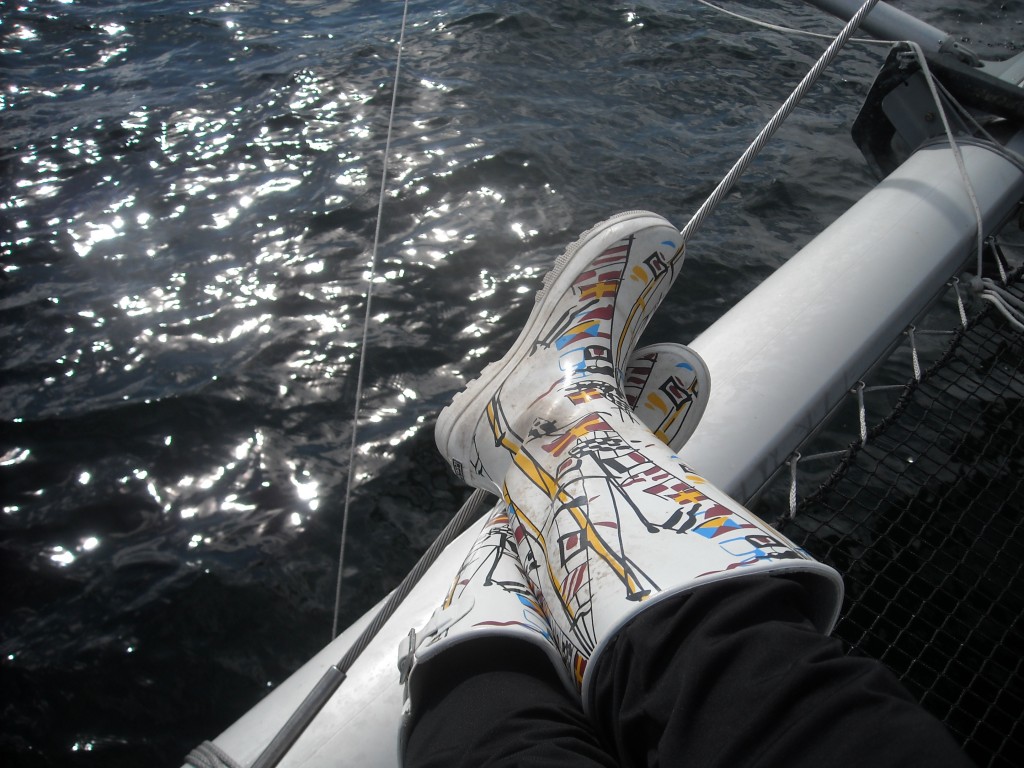
I love my life!
After an early start the group finally made it to Bellingham, WA where we met the Gato Verde, and Captain Todd, for the first time. Despite looking through past Beam Reach sailing photographs the “Gato†exceeded my expectations. When I was younger, I would always pester my dad to take me to the harbour to look out at the boats. This time, as I looked out onto the dock, a beautiful 42ft hybrid electric-biodiesel catamaran stared back at me. Our home for the next few weeks, the Gato stood out amongst the other vessels.  Never did I imagine that one day the ocean would be my classroom.
After having a brief tour of the boat—whilst it was safely fastened to the dock— we began exploring our cabins and bringing fancy science equipment on board. My cabin was particularly quirky because it was positioned at the front of the boat and was accessed by a floor hatch. Although it seemed small, on first appearance, there was more than enough space for me to sleep comfortably in addition to housing my luggage (yes, I still haven’t mastered packing lightly).  In fact, I felt fortunate that I had one of two single ‘rooms’. Another feature of the boat that I loved was the ‘trampoline’ that spread the breadth of the fore deck. Fortunately, as this was just a ‘practice cruise’, the group found many opportunities to lie on the netting overlooking the water. We were hoping to get some bowriding Dall’s porpoise, but, we had no such luck.
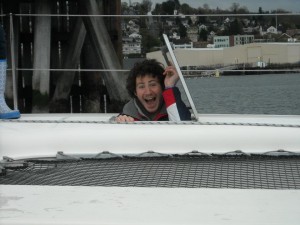
Peek-a-boo!
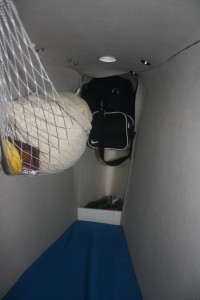
My cabin on the Gato
This particular four day excursion was intended as a way for us to adjust to life at sea. After a wobbly few hours we soon found our sea legs. Our mornings were structured around a chore schedule, and included tasks such as washing the decks, cleaning the heads, listening to the weather, and figuring out the tide tables. The person assigned ‘navigator for the day’ was required to propose a route to be followed.  Another person was appointed ‘science lead’, and was responsible for holding a morning meeting. Our morning meetings enabled us to devise science objectives for the day. Collectively, over the course of the trip, we were able to deploy a variety of science instruments. Such equipment included hydrophones; that allowed us to record ambient noise at Cherry Point (where a coal terminal has been proposed). In addition, we were able to measure for conductivity, temperature, and depth at several sites by deploying a CTD to varying depths. By doing this we were not only discovering the varying physical properties of sea water at different sites, but, also getting experience at handling heavy equipment on board a rocky boat. In addition to these experiments, we were also monitoring our own energy consumption. Daily, we kept records of our water consumption, sewage use, and amount of biodiesel remaining. These are all important factors to consider whilst sailing, especially when practicing sustainable science.
In addition to the science, and the log keeping, the group had a sailing lesson with Captain Todd. We learned the names of the various lines, in addition to having a crash course on wind. We each took turns at the helm where we attempted to tack. Tacking, or coming about, is a sailing manoeuvre where the bow of the vessel is turned through the ‘eye of the wind’. This is commonly done when the desired direction of travel is (nearly) into the wind. In order to tack on something of Gato’s size, it requires good team work and strong communication. I felt the group excelled at this.
Read More
Ever since my freshman year I have been hoping I would get into the Beam Reach program and now that I have it feels slightly surreal. We moved in to the Friday Harbor Labs this past weekend and  just began classes on Monday. We have only been here a week and it feels like I have known my classmates for much longer. When not in class, which is a short amount of time, we have been exploring Friday Harbor, venturing to Lime Kiln, and even learning how to row in rowboats… sort of.

I can already tell this is going to be an amazing quarter and I am going to be sharing it with some really awesome people.
We have hit the ground running in class with discussions on sustainability and defining what it means to each of us. I have discovered that it is a very difficult concept to sum in a few sentences but I’ll give it my best shot. I feel that sustainability science is a science that investigates and promotes technology that combines human and environmental goals in order to sustain and preserve our natural resources for further generations. Here at Beam Reach we focus on marine science while practicing sustainability. We are committed to studying the resident killer whales while minimizing our impact on them by using a diesel electric catamaran for collecting research called the Gato Verde. We will get to go out on the boat in a few weeks for a test run up to Cherry Point and I cannot wait.
This is going to be an incredible adventure, I hope you’re all enjoying life as much as I am.
Read More
After an amazing two weeks Spring break travelling from coast to coast, I have finally made it to the idyllic Friday Harbor Labs in the San Juan Islands. It is difficult to give the place justice through words alone. I feel so fortunate to be living for the next ten weeks in a place where tiny evergreen islands litter the sea and snow capped mountains touch the lapping waters. How can anyone be expected to study in such a gorgeous environment full of distraction? I feel I constantly want to be outside exploring! In some respects the area reminds me of Maine, however, on a more dramatic scale. Since meeting the other Beam Reachers, in Seattle little under a week ago, we have embarked on numerous adventures together. It is so great to be surrounded by like-minded students who share a passion for conservation and the environment. If you wander past the ‘S1 duplex’, regardless of time of day, one can expect to hear music playing and the sounds of laughter in the air.  Yes, there has been lots of laughter! It has also been great integrating with the other students and researchers at the lab. Hearing about their work, I would argue that the quality and diversity of the research generated at the lab is astonishing.
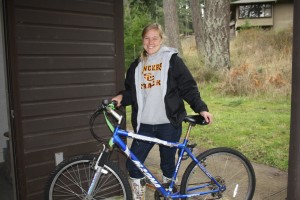
Rachel: Lots of exploring to do!
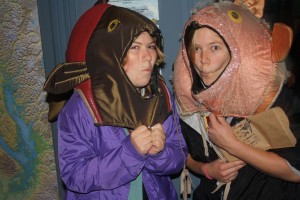
Did I mention loads of laughter?
As a class, it feels that we have already learnt so much; way more than I could have envisioned at the start of the week. So far, we have covered basic whale biology, killer whale family structure, population trends, and even dipped in to whale genealogy. In addition to the marine mammal component of this ten week intensive course, we are also learning the methods of practicing sustainability science. But what does this involve? After numerous discussions, both inside and outside of the class room, it has become evident that the scope of ‘sustainability science’ is broad, and the definition specific to each individual. Throughout the week, having grappled with some case studies and current literature, I have found my own personal definition to have evolved. At the moment, I would describe it as an interdisciplinary approach to science that takes into consideration local and global perspectives, whilst remaining conscious of environmental, social and economic factors. Through innovation, education, and the evaluation of current practices we can both mitigate and minimize our footprint on both a regional and global scale. Because this is still a working definition, my hope is to revisit and reference it throughout the quarter. I would encourage any readers to pause for a moment and think of their own definition. I would also like to draw the reader’s attention to RE-sources; a local organization run from Belligham, WA. (http://www.re-sources.org/home). Katie Fleming, a RE-source community outreach manager, came in to draw our attention to local sustainability science issues, and the things we [students] can do to get involved. I was particularly impressed by the examples she gave that highlighted various methods, such as workshops and citizen training, used by RE-source to empower local communities.  Hearing the perspectives of an outside source has been insightful. In addition to Katie Fleming, Lynne Barre from NOAA came in to give an overview of Southern Resident Recovery.
Given the success of the first week, I can’t wait to find out what next week has in store for us!
Read More
After a very long, ten day road trip, which began in Tucson, Arizona, I finally made it to Friday Harbor on the island of San Juan! My new home for the next ten weeks, the Friday Harbor Labs, is full of friendly people, sumptuous food, and a never-ending list of things to explore , like scenic running trails and quaint rowboats. Friday Harbor is one of the most beautiful places I have ever seen and I am so excited to embark on this enriching adventure with my new wonderful friends, Jamey, Breanna, Taya, Phinn, and Dana!
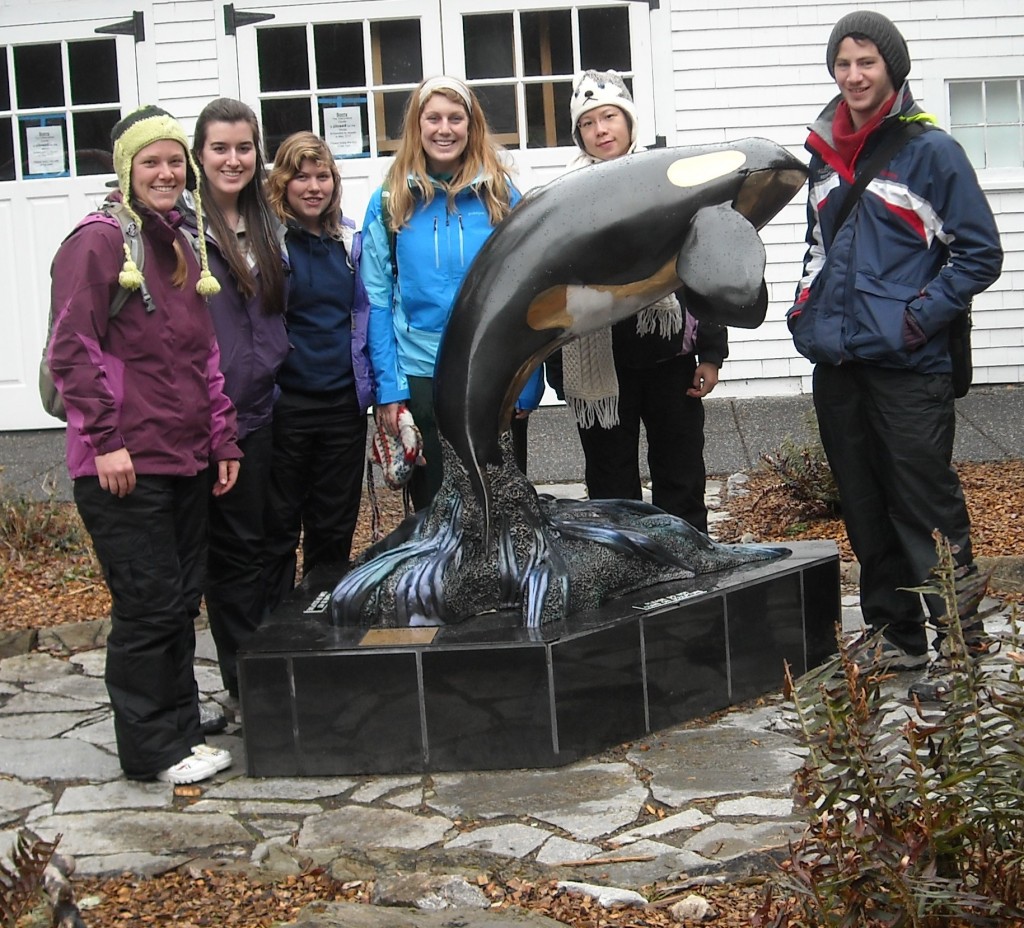
Me, Dana, Jamey, Breanna, Taya, and Phinn on our first excursion to Lime Kiln
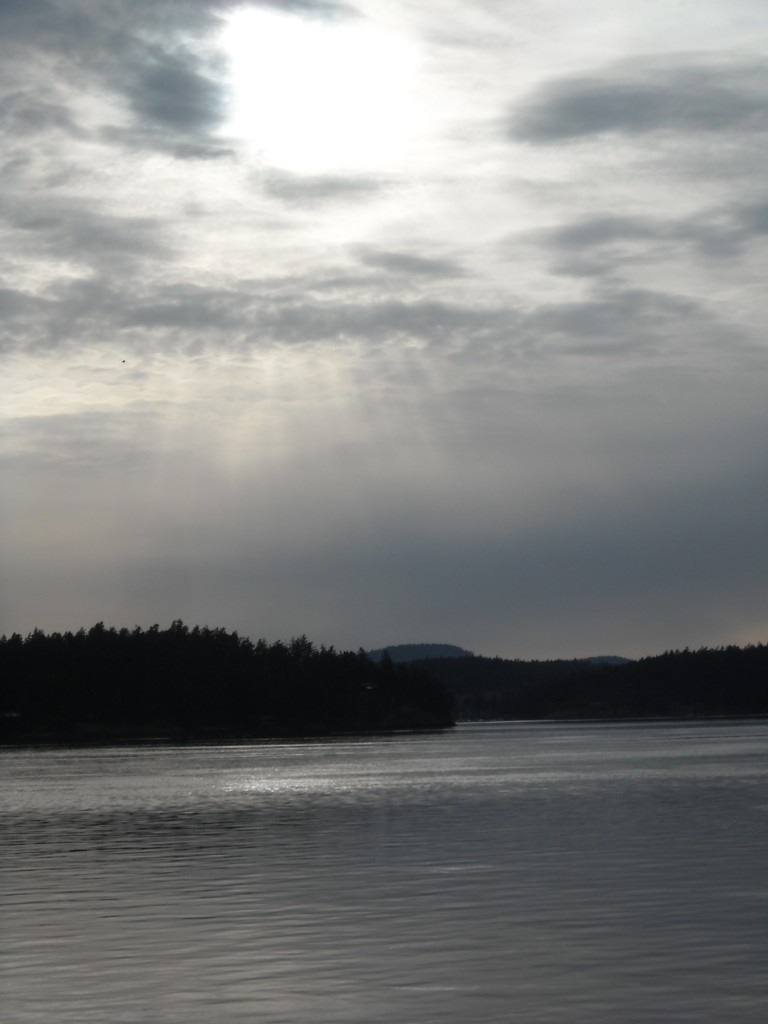
Class began on Monday, March 26 and has thus far been very interesting. We have learned quite a bit about killer whales and have just touched on the topic of sustainability science. Sustainability science does not have one set definition, but can be somewhat described as a combination of preserving the environment throughout the developments of the human population and improving scientific practices to sustain society. It is not only viewed through an environmental perspective, but also economically and socially. I found a description of sustainability science in a recently read paper to be rather enticing: enhancing human prosperity while protecting the Earth’s life support systems and reducing hunger and poverty. I felt that the emphasis on human prosperity in addition to protecting the environment was really cool!
Outside of the curriculum, I have had some great bonding time with my new friends. The six of us have managed to explore town, the rowboats, and the food menu, and are hoping that our upcoming adventures will provoke much more laughter and prove to be even more exciting!

Friday Harbor Labs
Read More
































 Twitter
Twitter LinkedIn
LinkedIn Facebook
Facebook